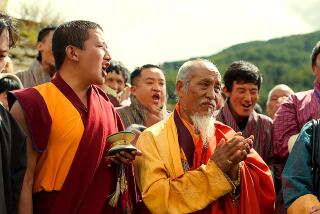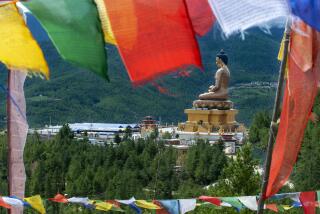Traditions of Bhutan
- Share via
The natural beauty of Bhutan, a tiny, forested country nestled between Tibet and India, will be celebrated Sunday at Cal State Northridge in a performance by traditional Bhutanese musician Jigme Drukpa.
Drukpa, who plays a lute-like instrument called a dranyon, says he is trying to do his part to keep the Bhutanese culture alive.
“He has an important role because the world is changing at a very rapid pace and because of the forces of globalization,” said Yeshey Dorji, a counselor at the Bhutan Permanent Mission to the United Nations in New York. “We have to be aware of the dangers that are inherent in such changes. People like Jigme help to preserve our traditional music and dance.”
Drukpa’s music includes Buddhist and secular works. In Bhutan, a country with 600,000 people, Mahayana Buddhism is the state religion, and monks and nuns make up about 10% of the population. But it is in Drukpa’s folk music that the beauty of the country is illustrated best.
Drukpa learned how to play his first instrument, a bamboo flute called dong lim, when he was 9 years old and spent his school vacations herding cows near the village of Wongchilo.
“You’re all alone among the cows, you long for company, you are two or three miles from your home--deep into the forest and high in the Himalayas,” said Drukpa, an ethnomusicologist.
Nature was the focus of his music. Drukpa first heard the dranyon on the radio in Bhutan about 20 years ago. Years later, he learned to play the instrument from Bhutan’s master musician Apa Dawpe.
“The sound is nearest to a human male singing voice,” said Drukpa of the instrument, which is made from the wood of a rhododendron tree. The head of the instrument is carved into a dragon’s head, an appropriate motif coming from a country known as the land of the dragon.
After earning his bachelor’s degree in Bhutan, Drukpa studied ethnomusicology for six years in Norway, where he made his first CD, “Endless Songs from Bhutan,” on the Norwegian label Grappa Musikkforlag.
Although Drukpa sings in Bhutanese, he explains the meaning of the songs in English. Drukpa is also a teacher and lecturer at Bhutan’s Royal Academy of Performing Arts in Thimphu. “Classical Bhutanese music has no rhythm,” he said. “There is no word in our language for rhythm. We concentrate more on melody patterns. There is a lot of melodic ornamentation.”
In Bhutan, the theme of music ranks at the top. There is an old saying in the country, “Judge not the words, but the melody. Judge not the melody, but the meaning,” said Drukpa. “My music is rather meditative. It’s nothing like jumping and shouting and shrieking.”
Roland Jackson, an ethnomusicologist in Fallbrook in San Diego County is one of three people who sponsored Drukpa’s trip to the United States. When he first heard Drukpa in Bhutan, he said, “I felt very overwhelmed and spiritually moved. This is a culture we’re not much aware of. His soulful singing is outstanding and very original. It’s sad and it’s also happy.”
With the relatively recent arrival of the Internet and television, life in Bhutan is expected to move into the fast lane. And Drukpa sees modernization as his biggest challenge to retaining Bhutanese musical culture. “I have a big responsibility to preserve, promote and make a balance between tradition and modernization,” Drukpa said. “And to pass this down to the younger generation.”
But he also wants his music to benefit Americans. “It would enable them to experience a different world,” he said. “Life in America is very fast. In a way, my music might help reduce the speed of life here, especially in the minds of the people here. Music is the product of our minds. My music might have a small impact in the minds of people here.”
BE THERE
Jigme Drukpa performs Sunday at 7 p.m. at the Cal State Northridge Performing Arts Center, 18111 Nordhoff St. (818) 677-3943. Free.


